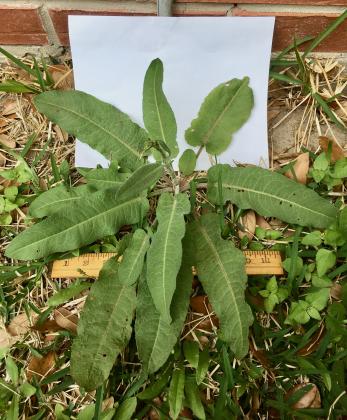Rumex crispus - Romans lost a 1st century scurvy cure for 1700 years
Rumex crispus, yellow dock, is a perennial seen year-round in southeast Texas. In late winter to spring there is a basal rosette that by summer has sent up a stalk 2 to 5 feet. It can be eaten raw or roasted. Flowering is in spring and early summer. Small, greenish-white flowers cluster around the stalk. Fruits are oval, about ¼ inch long.
Leaves are alternate, 6 to 10 inches with wavy or curly edges. One of its names is curly dock. Young leaves can be chopped for stir fry. Cook older leaves longer. There are recipes online for yellow dock soup, ravioli, etc. The whole plant is tangy, maybe bitter, but is nutritious especially in iron and vitamins A and C. Some suggest that yellow dock improves the bioavailability of iron in iron-rich foods.
Roots are 8 to 12 inches long, about ½ inch thick and edible. The flesh is from cream to dark yellow, getting darker as it matures which is where it gets its common name. Roots are harvested when leaves have died back in autumn. You’ll see rust-colored stalks and seeds that persist through winter and remain viable for more than 80 years in soil. They can be ground for flour or roasted to create a coffee-ish drink. The seeds have been eaten as cereal for millennia. In 1950 the Tollund Man, who lived in the 4th century BCE, was found mummified in a Denmark peat bog. Yellow dock was part of his last meal.
In traditional medicine the root is used to treat anemia and other blood disorders, constipation, chronic skin diseases, diabetes, etc. The mashed root is used as a poultice or salve. Dried, it’s used as a powder for skin conditions and as a dentifrice. R. crispus is in the Food and Drug Administration Poisonous Plant Database at fda.gov.
Pliny the Elder (23 - 79 CE), a Roman naturalist, saved Roman sailors from scurvy when they were fighting in what is now the Netherlands. Scurvy is a disease resulting from a lack of vitamin C. A native told him local yellow dock was a cure. Using the information, Pliny cured the soldiers and wrote about it. Unfortunately, vitamin C knowledge was lost to the Romans for hundreds of years until James Lind (1716 - 1794), a Scottish doctor, studied old texts about scurvy cures and realized that vitamin C was the answer.
Yellow dock is also used in weaving and dyeing. More information about R. crispus is at the Native American Ethnobotany Database, naeb.brit.org and at the National Institutes of Health, NIH, ncbi.nlm.nih. gov. Following are a few of many NIH articles:
• “Bioactive compounds and health benefits of edible Rumex species-A review”.
• “Determination of antioxidant and antimicrobial activities of Rumex crispus L. extracts”.
• “Antidiabetic effect of nepodin, a component of Rumex roots, and its modes of action in vitro and in vivo”.
People with acreage should note that herbalists will buy yellow dock root or pay for access to it.

